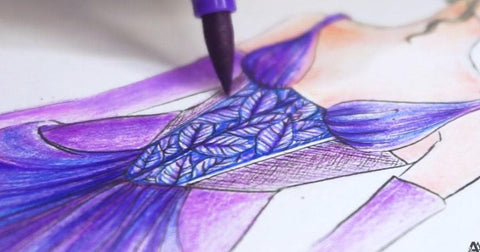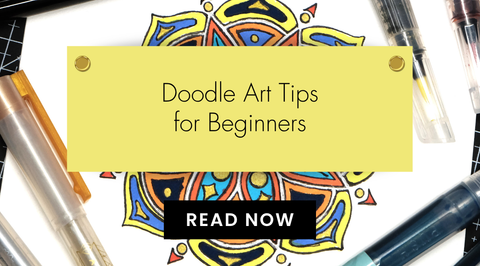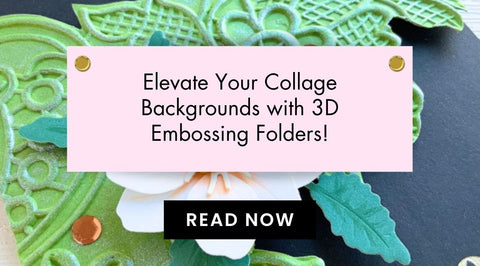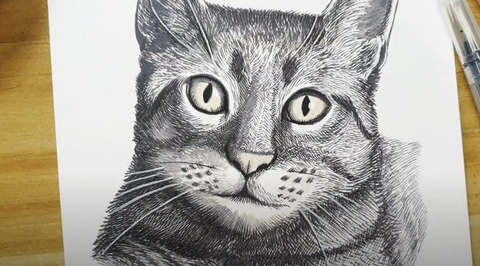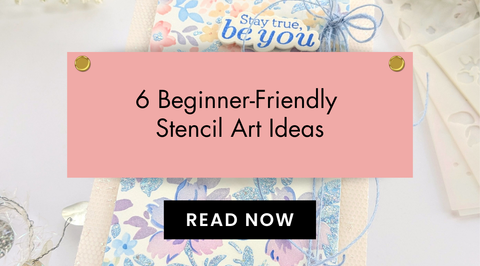Easy Stencil Art for Beginners
Last Updated: May 23, 2025
Are you a beginner artist looking for a creative hobby that’s simple, fun, and budget-friendly? Stencil art might be exactly what you need. It's the perfect way to make beautiful, professional-looking art without needing to know how to draw.
If you’ve ever wanted to create something visually stunning without the pressure of freehand sketching, stencils will be your new favorite tool. And the best part? You don’t need a big budget, a studio, or years of experience. Just a stencil, some color, and your imagination.

One of our favorite starter tools is the Stencil Art: Ditsy Flowers Wallpaper Layering Stencil Set (7 in 1). It’s designed to be incredibly beginner-friendly and lets you explore a world of floral creativity without having to sketch a single petal.
What Is Stencil Art?
Stencil art is a simple technique where you apply paint, ink, or another coloring medium over a stencil. Once you lift the stencil, a crisp, beautiful pattern is revealed underneath. This makes it perfect for beginners, you can instantly create eye-catching artwork without having to worry about precision or drawing skills.

Why Beginners Love the Ditsy Flowers Wallpaper Stencil Set
For beginner artists, starting with a blank page can be one of the most intimidating parts of making art. Many people want to create something beautiful but feel limited by a lack of drawing experience or confidence. That’s where layering stencils, especially thoughtfully designed ones like the Ditsy Flowers Wallpaper Stencil Set, can make a big difference. This seven-piece set offers a gentle introduction to building up a composition without having to sketch every detail by hand. Each stencil features small, intricate motifs—delicate flowers and leafy elements—that can be used individually or layered together to create more depth.
Because the designs are separated into steps, this set naturally guides beginners through the creative process, helping them understand how to develop artwork in layers. The stencil size works especially well for common beginner surfaces like sketchbooks, journals, and smaller canvases. It's also compatible with many types of media, including ink, watercolor, acrylic paint, or even colored pencils—making it accessible for those still experimenting with different tools.
And perhaps most importantly, it offers a sense of accomplishment right away. With just a bit of blending or dabbing, you can quickly reveal a clean, polished result, something that’s encouraging for artists just getting started and looking for a creative win.
| “The Ditsy Flowers Wallpaper Stencil is a beautiful design to experiment with color. This illustration is arty and loose, and the flowers fill your card quickly. All you have to do is choose your colors.” - Anne F. |
What do I need to create stencil art?
You don’t need much to get started. Most of these tools are affordable and easy to find:
- Flower stencil set like the Ditsy Flowers Wallpaper Layering Stencil
- Inks, acrylic paints, watercolors, embossing paste, shimmer relief paste, or colored pencils
- A blending sponge, brush, or even an old makeup applicator
- Masking or washi tape to keep your stencil in place
- Paper, canvas, or any flat surface to stencil on
-
Optional: An easy-to-follow, virtual stencil art class!
6 Beginner Stencil Art Ideas (No Drawing Needed)

1. Floral Art Journal Spread
Tape down your stencil in a sketchbook or bullet journal. Lightly blend ink or paint through one or two layers of the stencil. Try overlapping the layers or changing colors to create a blooming garden scene. Add your favorite quote or a hand-lettered word to finish it off.
2. DIY Notebook or Folder Covers
Grab a blank notebook or folder and use your stencil to decorate the front cover. Try using watercolors, inks, or texture pastes. Add your name or subject title using alphabet stamps or stencils. You’ll create a piece that’s uniquely yours and functional.

3. Wall Art for Your Room
Use cardstock or canvas panels and stencil a bold floral design using vibrant colors. Layer two or three designs for depth and contrast. Once dry, pop it into a frame or hang it as-is. It's a great way to decorate your space with your own art.
4. Canvas Tote Bag Design
Use fabric paint and the stencil to create a custom tote bag. Floral stencils like the Ditsy Flowers set are perfect for adding a subtle, boho vibe to your accessories. This makes a great DIY gift too.
5. Personalized Bookmarks
Cut watercolor paper into strips and stencil simple patterns on them using light ink or watercolor. You can leave space to write a favorite word or quote. Punch a hole at the top and add a ribbon for a stylish, handmade bookmark.

6. Mixed Media Collage Background
If you love layering paint, papers, and texture, stencil art fits right in. Use stencils over old book pages, gessoed backgrounds, or watercolor washes to create complex, artistic layers. Use this technique in art journals, zines, or mini canvases.
Tips for Stenciling Success
- Use a light hand. Too much paint or pressure can cause color to seep under the stencil.
- Secure your stencil. Use washi tape or masking tape to keep it in place while working.
- Let each layer dry. Especially with layering stencils, patience helps prevent smudging.
- Practice first. Use scrap paper to test out new techniques or color combos.
- Clean your stencils. A quick rinse with water keeps them reusable and long-lasting.

Why Flower Stencils Are Great for New Artists
Floral designs are naturally forgiving. They don’t require perfect lines and you can play with colors freely. With flower stencils, your art can look detailed and beautiful with minimal effort. The Ditsy Flowers Wallpaper Layering Stencil Set is perfect for exploring different color palettes, textures, and creative layering—no drawing required. Whether you’re creating a nature-themed sketchbook page or designing a custom tote bag, flower stencils offer endless inspiration.
Create Beautiful Stencil Art in Minutes!
Starting something new can feel overwhelming, especially when you’re unsure where to begin or doubt your artistic skills. But creating art doesn’t have to be complicated. With tools like Altenew’s Stencil Art: Ditsy Flowers Wallpaper Layering Stencil Set, you can skip the pressure of perfection and focus on the joy of experimenting. The gentle guidance of layered stencils helps you understand composition and flow, even if you’ve never picked up a paintbrush before.
Your first creations don’t need to be polished—they just need to be yours. Whether you’re filling your sketchbook, decorating your space, or simply making art for the first time, stencil art offers a simple, accessible path to self-expression. You don’t need to know how to draw. You don’t need fancy supplies. Just a stencil, some color, and a willingness to try.
Visit The Creative Corner today and let your creativity grow—one layer at a time.
FAQs About Stencil Art
Q: How do you make a stencil for beginners?
A: Start simple. Draw a basic design on cardstock or acetate and cut it out with scissors or a craft knife. Or skip the hassle and start with ready-to-use custom stencils, like Altenew’s beginner-friendly flower designs.
Q: What is the trick to using stencils?
A: Apply color in small amounts using a sponge or blending brush. Gently dab (don’t rub) and remove the stencil carefully to reveal your design.
Q: How do you prevent paint from bleeding when stenciling?
A: Use less paint and a dry brush or sponge. Press down the stencil edges securely and build up color slowly.
Q: What’s better for stenciling—brush or sponge?
A: Both work. Sponges are great for quick coverage and soft effects. Brushes are better for detailed blending and sharp lines. Try both to see what feels more natural to you.


